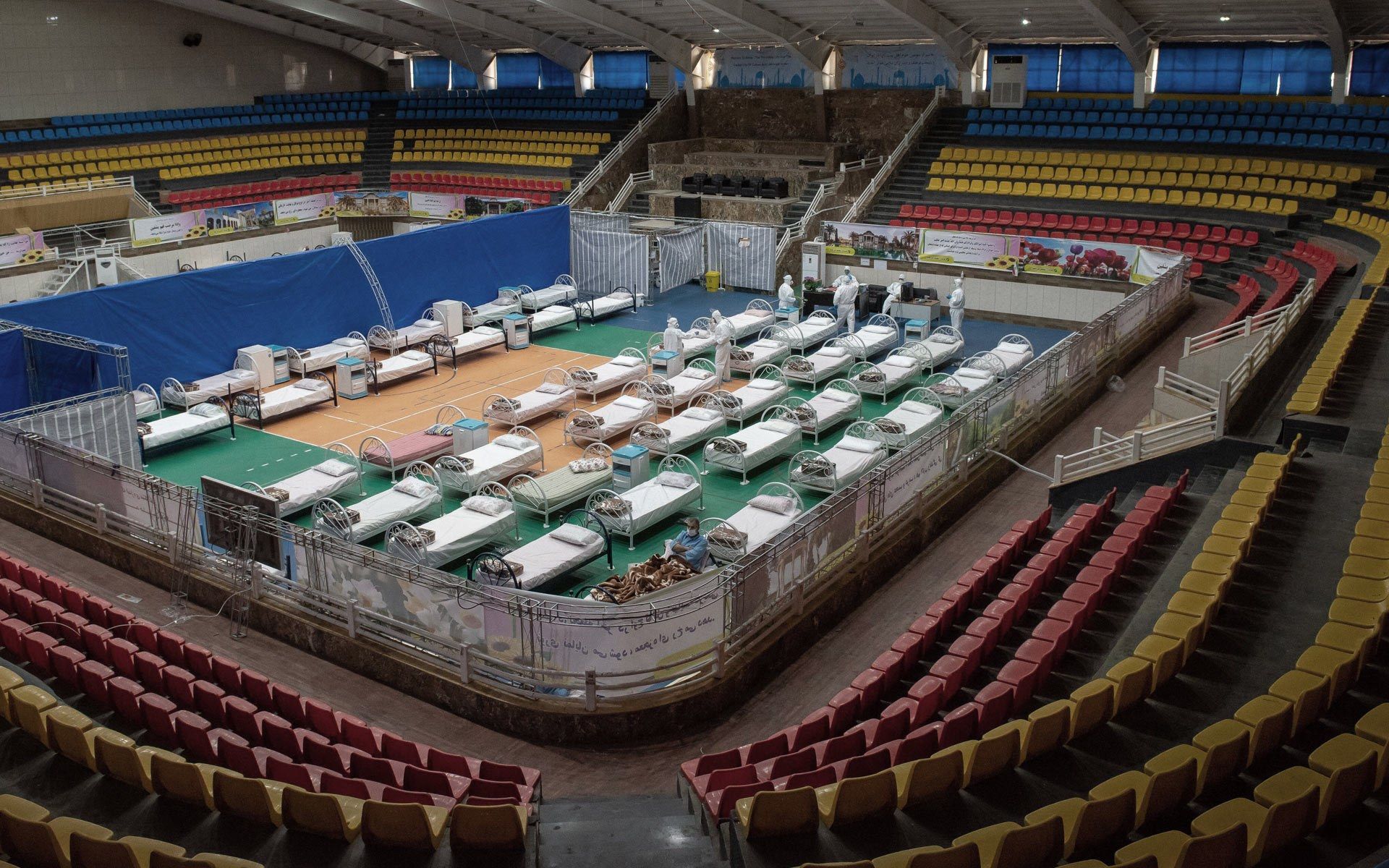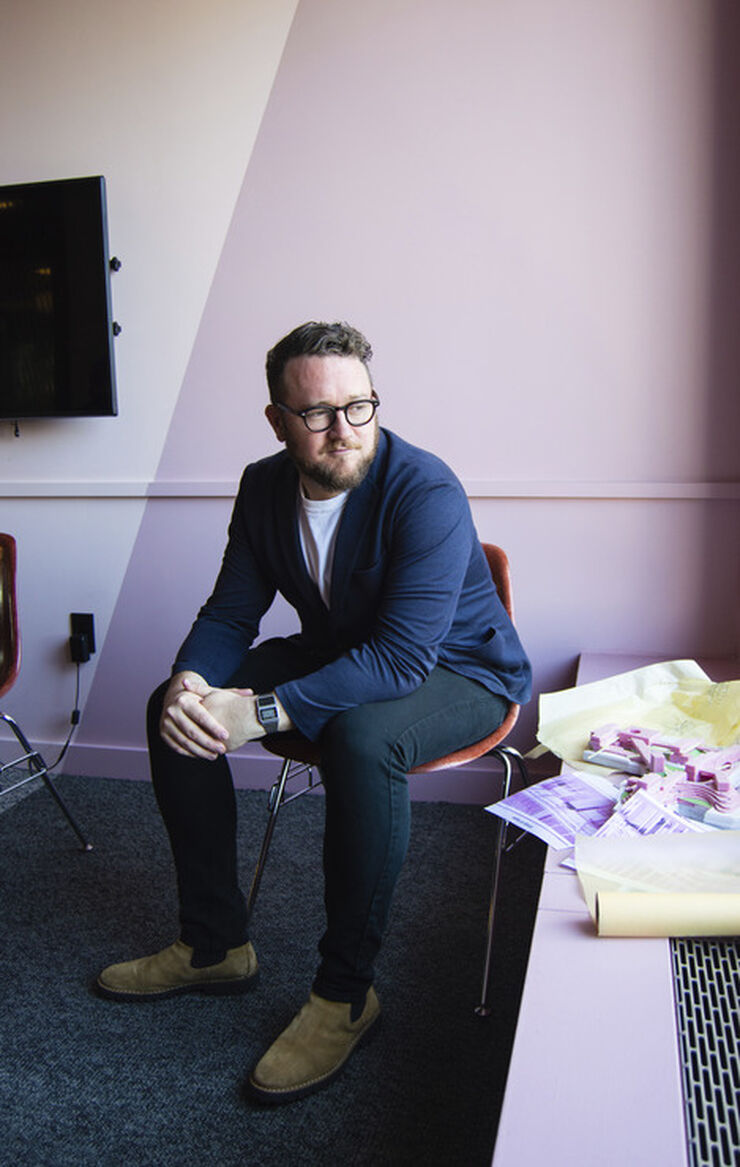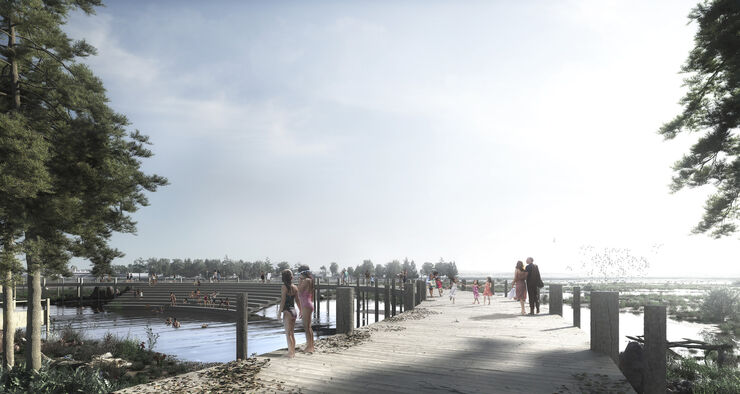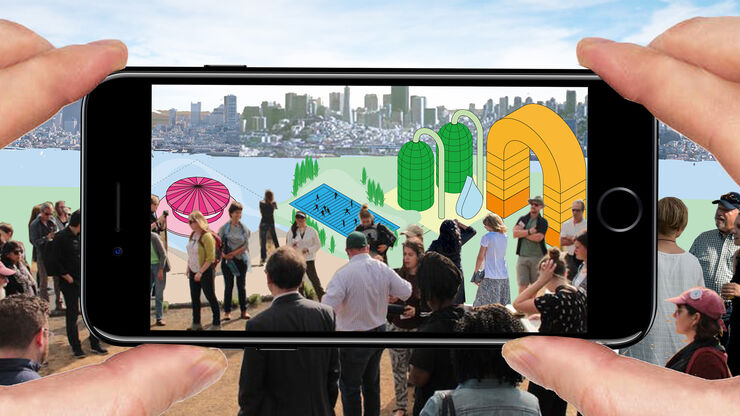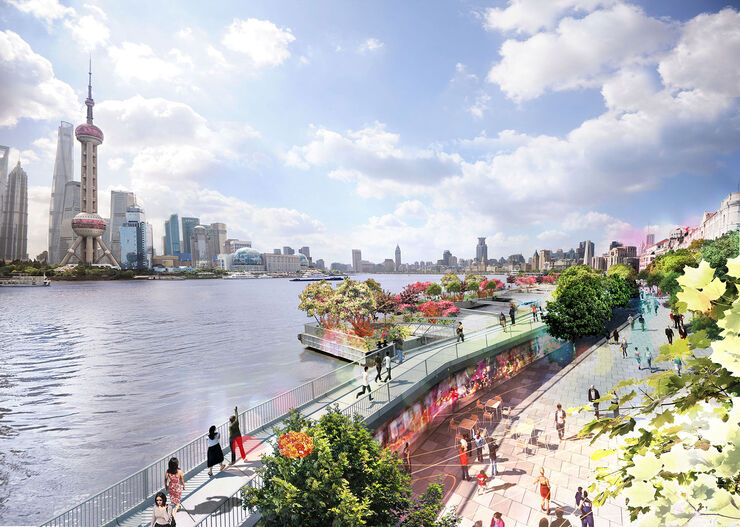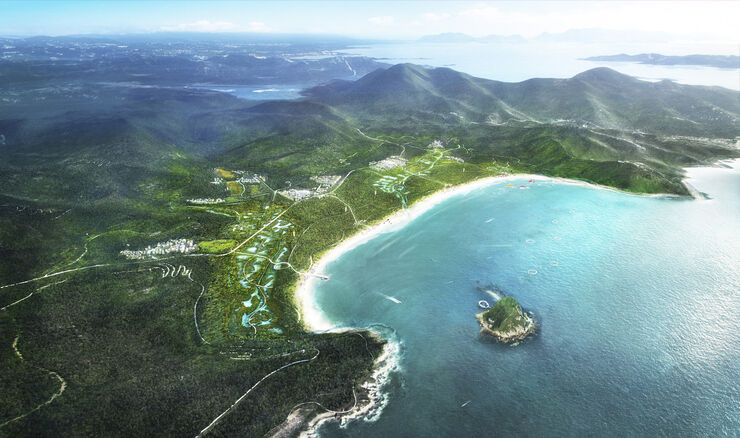Transcript
Richard Mullane introduces the episode:
Hey, Richard Mullane here. You’re about to hear a podcast recorded at the start of 2020, when fires were burning up millions of hectares in Australia’s landscape. Only a few weeks later, and COVID-19 is presenting us with a different type of crisis, but around the world, as governments go into crisis mode, and communities adapt and try to stay connected with information and each other, many of the aspects of the conversation, you’re about to hear becoming more and more relevant.
The Hassell-designed Perth Optus Stadium, for example, like Gymnasium at Yale and the Welsh National Rugby Stadium, has been converted into an emergency response centre and temporary care facility. It’s exactly this sort of flexibility and resiliency in our infrastructure that you’ll hear us advocating for in this conversation. I hope you enjoy the podcast.
(pause)
I’m Richard Mullane, a principal and urban designer in Hassell, San Francisco studio. Since 2017, major wildfires are burned across almost 8 million hectares of land in California. Thousands of people have evacuated, hundreds of homes have been lost. My home state of New South Wales has just had extreme fires, that burned an equivalent amount of Australia, including areas around Sydney. This has all taken place just since last October, and there too, those fires have claimed lives and property.
So my entire career I’ve spent designing for communities, neighbourhoods, city precincts, and public and shared places that support communities and allow them to thrive. I had just moved to California when the Tubbs Fire happened. I was working on a Rockefeller-sponsored resilience planning project there, and I remember watching smoke spread from the Tubbs Fire across the North Bay as I stood on Twin Peaks.
Here in California, I’ve met Greg Kochanowski, an architect studio director with Rios Clementi Hale in Los Angeles, and I wanted to talk to him about designing for resilience in a world where this risk is growing, and what we as designers can do for these communities in a rapidly changing climate. Hi, Greg.
Greg Kochanowski greets Richard:
Hi, Richard, how are you doing?
Richard Mullane responds:
I’m pretty good. I was trying to think how we met, just to do an intro here. How did we meet?
Greg Kochanowski:
We were introduced, I think, through a collaborative architect, and realised we had a lot in common.
Richard Mullane:
It’s true. We got nerding out on resilience and planning and all of that stuff.
Greg Kochanowski:
It’s just ridiculous. We did that project in Houston-
Richard Mullane:
That’s true-
Greg Kochanowski:
.… For resiliency 2020, and I think we speak the same language. It’s really interesting just that through circumstance, I guess, that the fires in California and none of the fires in Australia have given us more commonality, and more to talk about.
Richard Mullane:
And when people ask you, Greg, how would you define resilience?
Greg Kochanowski:
Resilience is really the capacity for an environment to recover. So in Southern California, all of the fires primarily have been manmade, and we have a relationship to the land in California that, although for the most part, it’s a very liberal state and we’re very environmentally focused, we have a policy of suppression, really, and thinking of the landscape is something to be battled against, rather than really the people who settled initially in California, the Native Americans had a much different way of thinking about the land, which they managed it and did controlled burns for agriculture.
Richard Mullane:
That’s another similarity with Australia, because indigenous Australians also had that connection and those skills.
Greg Kochanowski:
Yeah. And I think there’s something to be said about that in terms of thinking about ways forward.
Richard Mullane:
This topic is also personal for you as well as being professional. Do you want to talk a little bit about what happened to your family during the fire a few years ago?
Greg Kochanowski:
Yeah, sure. So my family lives in the Santa Monica Mountains, just north of Malibu. And during the Woolsey Fire in 2018, on November 9th, we were notified to evacuate. And so we packed up and drove out to Burbank. We lost our home in that fire. So we started to piece together what had actually happened to the community over a series of days, but out of 217 homes that are part of the community, we lost 110.
Richard Mullane:
Wow.
Greg Kochanowski:
It’s an interesting thing, being an architect and going through this, it’s become a life mission now, to study these issues and find better ways of developing in the wild/urban interface.
Richard Mullane:
So I wanted to bring in environmental reporter, and friend of mine, Molly Peterson, since Molly has some really valuable real world experience with people on the front lines of California’s natural disasters. Hi, Molly.
Molly Peterson:
Hey there.
Richard Mullane:
Bring us a different perspective. Get us out of this designer’s head space. You’ve covered all sorts of disasters like floods, hurricanes, heat, and wildfire. You started covering Katrina. Tell us a little bit about that.
Molly Peterson:
Yeah. I wasn’t just an environmental reporter there, I was covering schools, and courts, and housing, and insurance, and all the things that have to be rebuilt in a community after a flood, after a hurricane. There’s a lot of things that I’ve taken from Katrina that applied to all these other kind of natural disaster and in climate change challenges in California, that apply to heat and how heat affects our old housing stock, to covering fires.
Richard Mullane:
And who were the sorts of people that are most effected by these events? Who are you talking to mostly?
Molly Peterson:
So with these disasters, we know that there’s a social vulnerability that comes from different factors. It’s things like, in Katrina, people died who were old. In the Camp Fire in Paradise, in Butte County in Northern California, people were 72 on average. When it comes to heat, it’s people who can’t afford air conditioning, or can’t afford housing that has some sort of insulation, that was built at the right time, in a good way. So money and finances and access figures into all of it.
Richard Mullane:
An event might be something that takes place over one or two days, but I assume that the stories spend much longer periods of time, and it really impacts people’s lives over huge extent of time, yeah?
Molly Peterson:
One of the first people I talked to after Katrina was a friend of mine who lived on Esplanade Ridge in Mid-City New Orleans, and she knew from her burglar alarm that her door was open, and she knew the water had risen, but she didn’t know how far, and the water was high in that city for weeks. So people lived in agony for weeks at a time, and I know that’s the same for people who live in fire-prone areas where they scatter, and they may not be able to get back to see what’s happened to their property, to their neighbours. And I want to ask you about that, Greg, how did people connect after the Woolsey Fire? How do people connect in your community?
Greg:
Well, I’ve never been a proponent of Twitter. I’ve never used Twitter. My family and I lived on Twitter for weeks, but really it was the input of information that we really needed. So it’s connecting to people, but it’s also what the heck is going on, and in that situation, what you’re looking at is, is my house gone, or is it there? Are the roads closed? Is the highway still blocked off? And technology is something that we don’t think of that often in disasters. I think that, at least as designers, we don’t.
Molly Peterson:
I hear stories like Greg’s a lot, because people are scattered from their communities, and they’re looking for answers.
Richard Mullane:
There’s a former Australian Senator who just went through a similar thing happening to his community, in the south coast in Australia, and he described the emergency centre, and seeing his community look after each other. And I think his quote was, “This is what community should feel like.” My understanding is that for those who go through these events, that they really rely on those connections. Was that your experience?
Greg:
Yeah. It’s essential. I was very relieved that I lived in the community that I did.
Richard Mullane:
I got a little bit obsessed with some old photos when we were doing our work in San Francisco, looking at how public space was used after the 1906 earthquake, and photos of the Presidio filled with tents for temporary accommodation, and temporary churches and schools, and then again, seeing that same phenomenon during the North Bay Fires a few years back, when the Sonoma Fairgrounds was this place for people come together, get vitally-needed services. I already mentioned the similar space in Australia. Just how important do you think public space is for communities in terms of resilience?
Greg:
I think it’s critical, because again, the term resilience cuts through in many different ways. So from a resilience standpoint, just in terms of the formation of the community, it’s that place where the community gets together. I think in terms of environmental resilience, it can become those places that, if they are within the heart of the psyche of the community, those can be places where people go to, to gather to, that might get them out of harm’s way. In California, for example, that place is the beach.
Richard Mullane:
Yeah.
Greg Kochanowski,
The beach was that place that everybody went to. And I think it was similar in Australia, it wasn’t even people who went to the beach-
Richard Mullane:
Absolutely, yeah, in Mallacoota, people were evacuated off the beach there. So that experience clearly changed the way that you would design a community in a site like that, and I feel like a lot of that is not very well understood.
Molly Peterson:
The public places that we have are bound by rules and by structures that we put into place a long, long time ago. Our rules for how we’ve organised our public places in our cities and our communities were put into place in California during this era of massive public works projects, concretization, dams and freeways, and we are bound by those decisions now. I’m wondering, what that does to your work, both of you as designers? How do you build resilience into something like that?
Richard Mullane:
Well, I think this goes to what Greg was saying about how we define resilience, yeah? Because a concrete levy or a dam is very inflexible. It might survive one event, but it certainly doesn’t adapt to a changing climate, and I’m interested in how we can better invest dollars in communities, in building social resilience, in building connections and allowing people to respond and survive disasters, and self-organise in how they change the form of their own communities, to be better placed for future disasters. Major infrastructure projects don’t deliver that, particularly if they’re single-use infrastructure projects.
Greg Kochanowski,
Yeah, [crosstalk 00:11:21]-
Richard Mullane:
You were showing me some photos of some pretty amazing concrete infrastructure. I don’t even know what that thing was. What was that?
Greg Kochanowski,
Debris basins. [crosstalk 00:11:29].
Richard:
What the hell is a debris basin?
Greg Kochanowski,
Well, essentially, it’s a big bucket. It’s a big concrete bucket that sits at the bottom of the mountain and-
Richard Mullane:
What do they do, what are they there for?
Greg Kochanowski,
Well, what they do is they catch debris. So Los Angeles is really unique in that, well I don’t think it’s unique globally, but it has a problem where fire has a cycle to it, then the rains come. And then those rains, because the hillsides are burned out, they create landslides, or debris flows.
Richard Mullane:
Wow.
Greg Kochanowski,
So soil comes off of the mountains during an event, and more or less pile up there. And then the interesting part about them is that the city expends an enormous amount of energy and money to maintain them. The difficult part of it, and this gets back to the issue of the singular nature of some of these, and the hardening of infrastructure, is that mountains want to connect with the ocean, that’s the natural processes. So as we interrupt those processes through debris basins, and by building communities up against them, then we have to come back and actually do all this enormous amounts of expenditure to maintain that system. Where if you created a softer system, like what you’re talking about, maybe there’s another avenue through which you create more resiliency, more protection-
Richard Mullane:
Yeah, it has more than one use, possibly.
Greg Kochanowski,
Absolutely. Yeah. That’s more multivalent.
Molly Peterson:
So is that an example of climate change making design more urgent, and raising the stakes for what you’re doing?
Greg Kochanowski,
Climate change puts everything into question. It reveals decisions that were made in the past, that you can’t really replicate anymore. Those were models that believed that infrastructure was a singular entity, and highways deliver people, debris basins capture material [crosstalk 00:00:13:38]-
Richard Mullane:
They’re fixed solidities for what are not fixed problems.
Greg Kochanowski,
Exactly. And so as climate change is rapidly changing and actually as climate policy can’t even keep up with the amount of change that’s happening in the environment, our infrastructure needs to operate similarly.
Richard Mullane:
I’m hopeful that the design is a little bit more important. I think we’re talking about a different type of design thinking, we’re talking about a more holistic design thinking, not engineers leading this process, because as we’ve talked about, it’s inherently a social challenge, yeah? As well as an infrastructure-based one.
Greg Kochanowski,
I tend to think that resiliency is born more out of ground-up processes than top-down processes.
Molly Peterson:
I’m listening to you guys talk about how you’re influenced by and thinking about things in the face of these climate-driven disasters, these fires, and something I’ve noticed by talking to people in communities after these fires is that people feel more engaged and empowered. This is a community that’s in some trauma, and people take it really personally. And so they want to step up and participate in this process more. Is that something, Greg, that you’re seeing in your community?
Greg Kochanowski,
Yes, I think so. In fact, in our community, we’re forming a fire safe council and educating people, and part of actually the rebuilding process is an education process. And that education process brings people together to share information, and share experiences, and grow the intellectual capital of the community to make it more resilient. [crosstalk 00:15:20].
Richard Mullane:
Yeah. And that process also connects people to each other. And something that we’ve talked about, Molly, is San Francisco, the City of San Francisco puts resilience dollars into connecting communities with each other. And they do it through a programme that allows communities to run their own block party. And it’s not something that you think of as a resilience measure, but the outcomes of them self-organising that event are that they know each other, they know where the most vulnerable, the older people, are, or those who live alone, or with disabilities.
Greg Kochanowski,
That’s right.
Richard Mullane:
This is important stuff to know about, and it becomes far more important when you’re in the middle of a disaster. Yeah.
Molly Peterson:
Something I’ve noticed is that when these disasters break things down, these flaws in our design are revealed to us. There’s this moment where people feel empowered to participate, where they’re looking at each other, they’re looking for answers from their local community, from the people who are helping them design their communities, to survive the next fire. So what’s the best thing a designer can tell people in that circumstance?
Greg Kochanowski,
It’s funny. I think one of the best things that a designer can do is listen, instead of tell. A lot of the solutions are already there, and it’s the role, I think, of the designer in that situation to help make connections for people between things that they might think don’t really matter, or aren’t connected to each other, and then to bring in external information to help support that, or supplement it, in a way, and bring it maybe to a level that they couldn’t realise themselves or couldn’t envision themselves.
Richard Mullane:
I think one thing is that if we put all resilience plans, traditional resilience plans to the side for a moment, infrastructure-led things, engineering-led things, and we look at design as a process, and how it can be part of this ground-up movement. I think there’s a lot of potential for design to start with raising awareness, and for it to be much more engaging with communities, yeah? So for it to be about outreach, primarily, about education, and then for it to pass tools and processes onto communities to self-organise their own responses.
Greg Kochanowski,
Yeah. I would agree. I think sometimes we feel as though we’re going to come in and tell people, “Here’s our brilliant idea how to solve your problem,” and as much as we are educating them it’s a process of us being educated ourselves.
Richard Mullane:
Greg Kochanowski, Molly Peterson, thank you so much for your time. I’m Richard Mullane. This is Hassell Talks.
